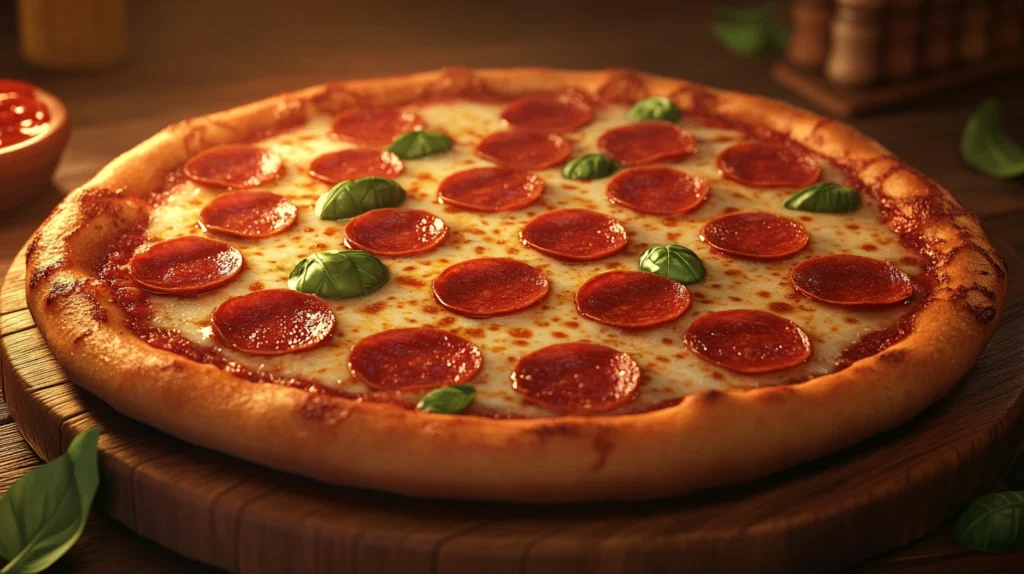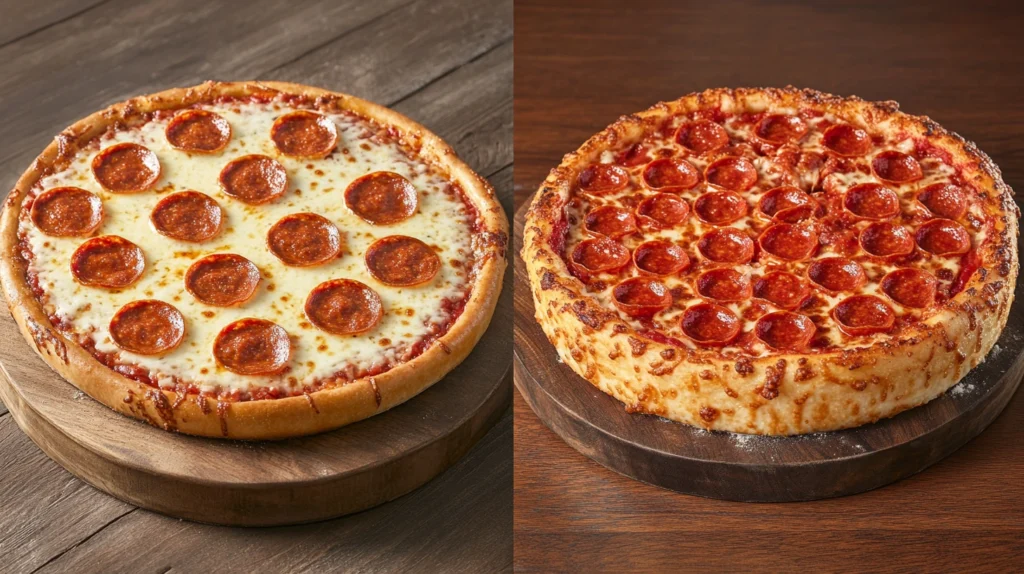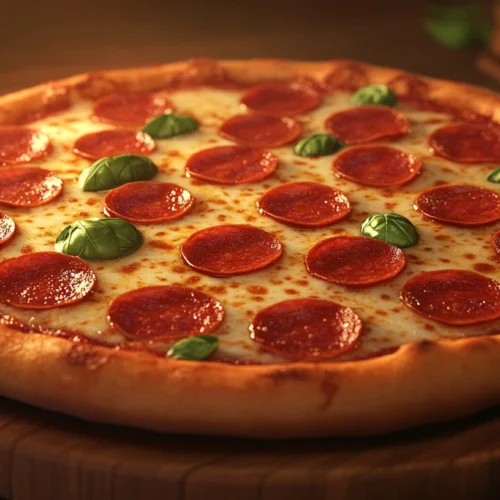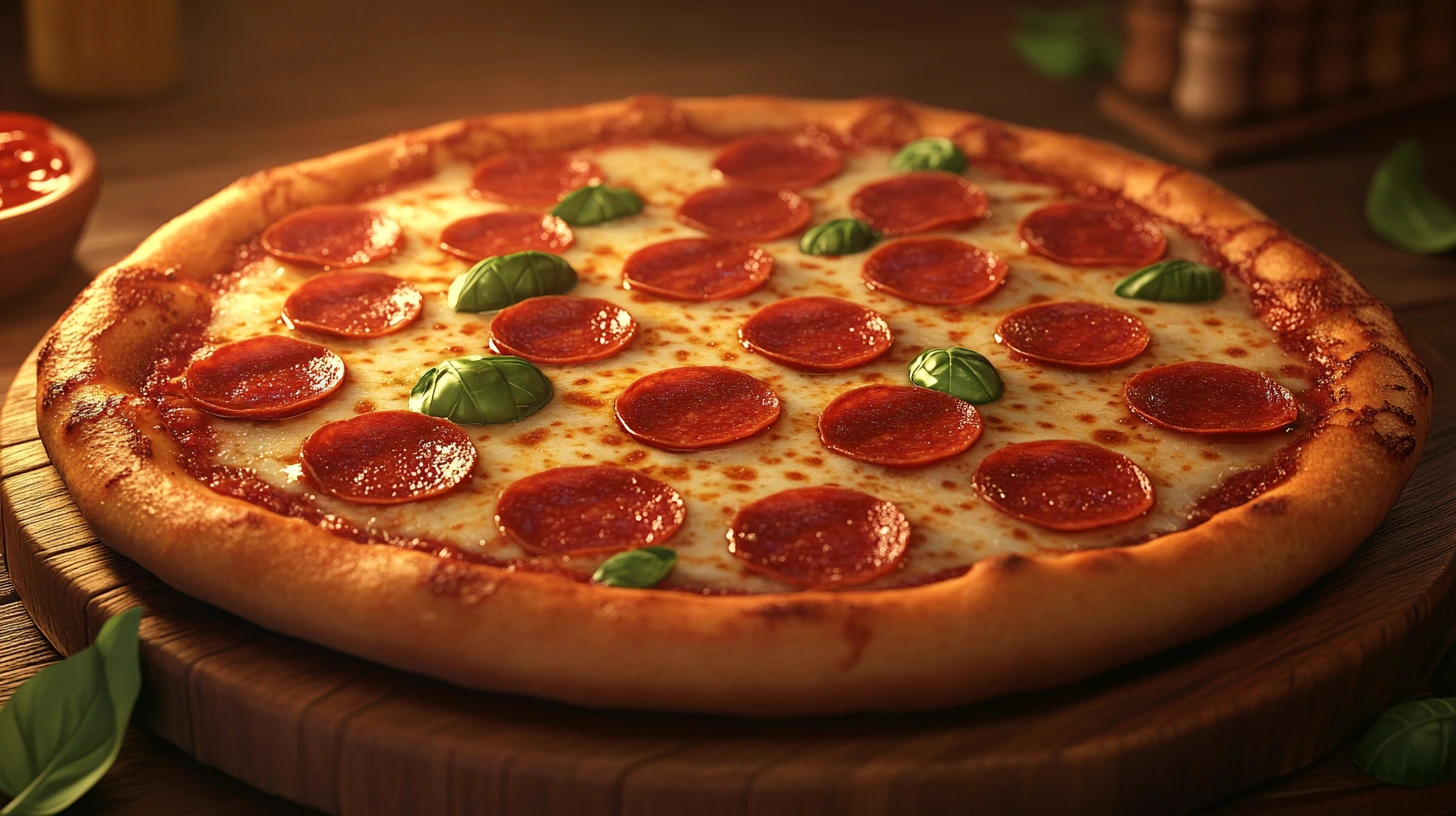Pepperoni pizza is one of the most iconic and beloved foods in the world. Whether you’re grabbing a quick slice on the go or enjoying a homemade version with friends and family, this pizza remains a top choice for millions. But what makes pepperoni pizza so special? Is it the crispy, slightly spicy pepperoni slices? The gooey, melted cheese? Or the perfectly baked crust that holds everything together?
In this comprehensive guide, we’ll dive deep into the origins of pepperoni pizza, explore its ingredients, learn how to make it at home, and even discover its variations across different regions. Whether you’re a pizza lover looking to perfect your homemade version or just curious about the history of this classic dish, this article will provide everything you need to know about pepperoni pizza.
A Brief History of Pepperoni Pizza
Pizza, in general, has a long history that traces back to ancient times, but the modern pepperoni pizza as we know it today is largely an American creation. While traditional Italian pizzas often featured simple toppings like tomatoes, cheese, and basil, it was in the United States that the spicy, cured meat known as pepperoni became a popular topping.
By the early 20th century, Italian immigrants in New York and other major cities began adding pepperoni to their pizzas, and it quickly gained popularity. The combination of crispy, spicy slices of pepperoni, savory tomato sauce, and melted mozzarella cheese proved to be irresistible, turning pepperoni pizza into a staple of American cuisine.
Why is Pepperoni Pizza So Popular?
Pepperoni pizza’s widespread appeal can be attributed to several factors:
- Perfect Flavor Combination – The mix of tangy tomato sauce, creamy mozzarella, and salty, slightly spicy pepperoni creates a taste that pleases almost everyone.
- Crispy & Chewy Texture – The crunch of the crust, the chewiness of the cheese, and the crisp edges of the pepperoni create a satisfying bite.
- Customizable & Versatile – While pepperoni is the star, you can add extra toppings like mushrooms, onions, or peppers to create a unique version.
- Widely Available – Almost every pizzeria, from local shops to major chains like Domino’s and Pizza Hut, offers pepperoni pizza.
From its humble beginnings to becoming one of the most consumed fast foods in the world, pepperoni pizza has stood the test of time. But how did it evolve into the version we enjoy today? In the next section, we’ll explore the fascinating history and origin of pepperoni pizza.

The Origin of Pepperoni Pizza
The History of Pizza
Pizza has a long and fascinating history, dating back to ancient civilizations. The earliest form of pizza can be traced to the ancient Greeks, Romans, and Egyptians, who baked flatbreads topped with simple ingredients such as herbs, oil, and cheese. However, the modern pizza we recognize today originated in Naples, Italy, in the late 18th century.
In Naples, the first Margherita pizza was created with a combination of tomato sauce, mozzarella cheese, and basil, representing the colors of the Italian flag. This version of pizza became incredibly popular, and by the late 19th and early 20th centuries, Italian immigrants brought pizza to the United States, where it would undergo significant transformation.
The Invention of Pepperoni
While pizza was gaining popularity in America, a new ingredient was also making waves—pepperoni. Interestingly, pepperoni is not an Italian creation. The word “pepperoni” comes from the Italian word “peperone,” which means bell pepper in Italian. However, the spicy, cured meat we know as pepperoni was developed in the United States by Italian-American butchers and pizzerias.
Around the early 1900s, Italian-American delis and pizzerias in New York City started experimenting with spiced, cured sausage made from pork and beef, seasoned with paprika, garlic, and other spices. The result was a bold, smoky, and slightly spicy meat that paired perfectly with pizza.
How Pepperoni Pizza Became a Global Favorite
Pepperoni Pizza as we know it today gained immense popularity in the mid-20th century when pizzerias across the U.S. began offering it as a standard topping. Several key factors contributed to its widespread success:
- The Rise of Pizzerias – After World War II, pizzerias expanded across the U.S., with New York and Chicago leading the way in pizza innovation. Pepperoni became a preferred topping due to its rich flavor and easy availability.
- Fast-Food Revolution – Major pizza chains such as Domino’s, Pizza Hut, and Little Caesars started in the 1960s and 1970s, offering pepperoni pizza as their most popular item.
- Convenience of Frozen Pizza – By the 1980s and 1990s, frozen pizza became a household staple, with pepperoni as the top-selling variety.
- Cultural Influence – Hollywood movies, TV shows, and advertisements often depicted pepperoni pizza as the ultimate comfort food, reinforcing its popularity.
Today, pepperoni pizza is the best-selling pizza variety in the United States, and its influence has spread worldwide. Whether you’re in Japan, Brazil, or Australia, you’re likely to find some version of this beloved pizza.
Ingredients of a Classic Pepperoni Pizza
A perfect pepperoni pizza is all about balance—the right combination of crust, sauce, cheese, and, of course, pepperoni. While many variations exist, the classic pepperoni pizza follows a simple yet delicious formula. Let’s break down each essential ingredient and how it contributes to the overall flavor and texture of this beloved dish.
1. The Dough: The Foundation of Every Great Pizza
The crust is the base of the pizza and can vary in texture, thickness, and flavor. A traditional pizza dough consists of four basic ingredients:
- Flour – High-protein flour (such as bread flour) is best for a chewy yet crispy crust.
- Water – Hydration levels affect the texture; more water makes the dough airy and soft, while less water results in a crispier crust.
- Yeast – Active dry or instant yeast helps the dough rise and develop its signature texture.
- Salt & Olive Oil – These enhance flavor and contribute to a tender, yet firm crust.
Many pizzerias ferment their dough for 24–72 hours to develop complex flavors and create a light, airy texture.
Crust Variations:
- Thin Crust (New York-Style): Crisp and foldable, perfect for a classic pepperoni slice.
- Thick Crust (Chicago Deep-Dish): Buttery and dense, holding more cheese and sauce.
- Neapolitan-Style: Soft, slightly charred, and baked in wood-fired ovens.
2. The Sauce: A Tangy and Savory Base
A great pizza sauce provides a balance of sweetness, acidity, and umami. The most common ingredients include:
- Tomatoes – Fresh San Marzano or canned plum tomatoes are ideal.
- Garlic & Onion – Adds depth and aroma.
- Oregano & Basil – Classic Italian herbs that enhance the sauce’s fragrance.
- Salt, Sugar & Olive Oil – Balance the flavors and improve texture.
Some pizzerias cook their sauce for hours to intensify the flavors, while others use a no-cook sauce for a fresher, more vibrant taste.
3. The Cheese: The Gooey, Melty Goodness
No pizza is complete without cheese, and mozzarella is the top choice for pepperoni pizza because of its:
- Excellent meltability – It creates those iconic gooey cheese strands.
- Mild, creamy flavor – Complements the spiciness of the pepperoni.
- Golden browning – High moisture content leads to beautiful caramelization.
Other Cheese Variations:
- Provolone: Adds a slightly sharper, aged flavor.
- Parmesan: Sprinkled on top for extra umami.
- Cheddar: Sometimes blended for a richer taste.
4. The Star Ingredient: Pepperoni
Pepperoni is a spiced, cured sausage made from a mixture of pork and beef, seasoned with:
- Paprika & Red Pepper Flakes – Gives pepperoni its signature red color and mild heat.
- Garlic & Fennel Seeds – Adds a savory, slightly sweet depth.
- Salt & Nitrates – Helps with curing and preserving the meat.
When baked, pepperoni releases flavorful oils, crisping up at the edges and curling slightly, adding both texture and taste.
Types of Pepperoni:
- Regular Sliced Pepperoni: The standard topping used in most pizzerias.
- Old-World Pepperoni: Smaller, thicker slices that curl up and char when baked, offering a crispy bite.
- Turkey or Beef Pepperoni: Alternative options for those avoiding pork.
- Vegan Pepperoni: Made from seitan, tofu, or mushrooms, seasoned to mimic the real thing.
5. Optional Toppings: Enhancing the Flavor
While classic pepperoni pizza only includes cheese and pepperoni, some people like to add extra toppings for variety, such as:
- Mushrooms – Adds an earthy umami depth.
- Onions & Bell Peppers – Enhances sweetness and crunch.
- Jalapeños or Banana Peppers – Adds heat and tang.
- Black Olives – Provides a slightly briny, salty contrast.
Bringing It All Together: The Perfect Balance
A well-made pepperoni pizza is more than just a sum of its ingredients. The magic happens when everything comes together—the crispy crust, the rich tomato sauce, the gooey melted cheese, and the spicy, crispy pepperoni.
How to Make a Perfect Pepperoni Pizza at Home
Nothing beats the satisfaction of making a homemade pepperoni pizza with fresh ingredients and a crispy, golden crust. While ordering from a pizzeria is convenient, crafting your own allows you to customize every element—from the dough to the sauce and toppings—to your taste.
1. Preparing the Dough: The Foundation of a Great Pizza
A well-made pizza dough is the key to a perfect crust. Here’s how to make an easy, homemade dough:
Ingredients:
- 3 ½ cups all-purpose or bread flour
- 1 ¼ cups warm water (110°F/45°C)
- 2 teaspoons sugar
- 2 teaspoons salt
- 2 teaspoons olive oil
- 1 packet (2 ¼ teaspoons) instant yeast
Instructions:
- Activate the yeast: In a bowl, mix warm water, sugar, and yeast. Let it sit for 5–10 minutes until foamy.
- Mix the dough: In a large bowl, combine flour and salt. Add the yeast mixture and olive oil, then mix until a sticky dough forms.
- Knead the dough: On a floured surface, knead for about 8–10 minutes until smooth and elastic.
- Let it rise: Place the dough in a greased bowl, cover with a towel, and let it rise at room temperature for 1–2 hours or until doubled in size.
- Punch down & shape: Once risen, punch down the dough, divide it if making multiple pizzas, and roll it into a 12-inch circle on a lightly floured surface.
💡 For the best results, refrigerate the dough for 24–72 hours before using. This slow fermentation enhances the flavor and texture!
2. Making the Pizza Sauce: The Secret to Bold Flavor
A great pizza sauce is simple, flavorful, and doesn’t overpower the toppings.
Ingredients:
- 1 can (14 oz) crushed San Marzano tomatoes
- 2 cloves garlic (minced)
- 1 tablespoon olive oil
- 1 teaspoon oregano
- ½ teaspoon salt
- ½ teaspoon sugar
- ½ teaspoon red pepper flakes (optional)
Instructions:
- Sauté garlic in olive oil over medium heat for about 30 seconds until fragrant.
- Add tomatoes & seasoning, then stir well.
- Simmer on low heat for 10–15 minutes until slightly thickened.
- Let the sauce cool before spreading it on the pizza.
💡 Want a fresher taste? Use uncooked crushed tomatoes mixed with olive oil and seasonings instead of simmering!
3. Choosing the Right Cheese: The Perfect Melt
For a gooey, stretchy cheese pull, use:
Whole milk mozzarella – melts smoothly and has a creamy flavor
Low-moisture mozzarella – creates a slightly firmer, golden-brown top
Provolone & Parmesan – blend them for extra depth
💡 Avoid using pre-shredded cheese—it contains anti-caking agents that prevent it from melting properly!
4. Assembling the Pizza: The Right Order Matters
Once your ingredients are ready, it’s time to build the perfect pepperoni pizza!
Step-by-Step Assembly:
- Preheat your oven to 500°F (260°C) for at least 30 minutes. If using a pizza stone, place it in the oven during preheating.
- Roll out the dough on a floured pizza peel or baking sheet.
- Spread a thin layer of sauce evenly across the dough, leaving about ½ inch of crust uncovered.
- Sprinkle shredded mozzarella cheese generously over the sauce.
- Arrange pepperoni slices evenly across the pizza.
- Add extra toppings if desired.
5. Baking the Pizza: Achieving the Perfect Crust
- On a pizza stone: Transfer the pizza directly onto the hot stone and bake for 7–10 minutes until the crust is golden and cheese is bubbly.
- On a baking sheet: Bake at 450°F (230°C) for 12–15 minutes for a crispier texture.
- In a wood-fired oven: Cooks in 90 seconds at 800°F (427°C)—ideal for Neapolitan-style pizza!
💡 For a restaurant-quality crust, brush the edges with olive oil and sprinkle with garlic powder before baking!
6. Serving & Enjoying Your Homemade Pepperoni Pizza
Once baked to perfection:
Let the pizza rest for 2–3 minutes before slicing—this prevents the cheese from sliding off.
Pair it with a side of garlic knots, ranch dressing, or a crisp Caesar salad.
Enjoy with a cold drink—cola, beer, or a glass of red wine complements the flavors beautifully!
Pepperoni Pizza Variations Around the World
While the classic American-style pepperoni pizza is a favorite worldwide, different regions have put their unique spin on this beloved dish. From thin-crust New York slices to cheese-loaded deep-dish Chicago pies, let’s explore the diverse variations of pepperoni pizza across the globe.

1. New York-Style Pepperoni Pizza 🍕🏙️
Characteristics:
Large, foldable slices with a crispy yet chewy thin crust
Generous tomato sauce and mozzarella cheese
Classic round shape, baked in gas ovens
Cup-and-char pepperoni that crisps up at the edges
Why It’s Popular:
New York-style pizza is one of the most iconic variations, famous for its huge slices and perfect balance of crust, sauce, cheese, and toppings. The high-gluten dough creates a chewy texture, while the high-temperature baking results in a slightly charred crust.
💡 Best enjoyed folded in half while walking the streets of NYC!
2. Chicago Deep-Dish Pepperoni Pizza 🍕🏙️
Characteristics:
Thick, buttery crust, baked in a deep, round pan
Layers of cheese first, toppings second, sauce on top
Takes longer to bake due to its thick structure
Often eaten with a fork and knife
Why It’s Popular:
Unlike traditional flat pizzas, Chicago deep-dish is almost like a pizza pie, with a crispy yet tender crust that holds loads of cheese, toppings, and chunky tomato sauce. The thick layers of mozzarella make it extra indulgent.
💡 Best enjoyed in small slices—it’s super filling!
3. Italian vs. American-Style Pepperoni Pizza 🇮🇹🇺🇸
Many people assume pepperoni pizza originated in Italy, but it’s actually an American invention. However, Italy has its own take on spicy salami-topped pizza.
Italian “Diavola” Pizza (Spicy Devil’s Pizza) 🇮🇹🔥
Uses spicy salami (not traditional American pepperoni)
Features a thin, wood-fired crust
Uses fresh mozzarella, olive oil, and basil
Cooked in wood-fired ovens at extremely high temperatures
💡 In Italy, you won’t find “pepperoni pizza”—ask for “Pizza Diavola” instead!
4. Detroit-Style Pepperoni Pizza 🍕🚗
Characteristics:
Rectangular, thick, airy crust with crispy, caramelized edges
Cheese and toppings extend all the way to the edges
Pepperoni placed under the cheese (sometimes)
Baked in steel pans for an ultra-crispy bottom
Why It’s Popular:
Detroit-style pizza is a fusion of Sicilian and deep-dish styles, known for its fluffy yet crispy crust and unique cheese-covered edges. The crispy caramelization of the cheese on the sides makes it extra delicious.
💡 Traditionally made in repurposed automotive steel pans—Detroit’s pizza history is tied to its car industry!
5. Unique Twists on Pepperoni Pizza Around the World 🌍
Many countries have taken pepperoni pizza and given it a local twist:
- Brazil 🇧🇷: Uses Catupiry cheese (a creamy, soft cheese) with extra toppings like green olives.
- Japan 🇯🇵: Features corn, mayonnaise, and seafood alongside pepperoni.
- India 🇮🇳: Often includes spiced tandoori chicken with pepperoni.
- Mexico 🇲🇽: Adds jalapeños and chorizo for extra heat.
- Australia 🇦🇺: Sometimes topped with barbecue sauce instead of tomato sauce.
Health Considerations and Nutritional Facts of Pepperoni Pizza
While pepperoni pizza is undeniably delicious, it’s often considered a high-calorie, indulgent food. But how unhealthy is it really? In this section, we’ll break down its nutritional profile, explore healthier alternatives, and discuss how to enjoy pepperoni pizza in a balanced diet.

1. Nutritional Breakdown of Pepperoni Pizza 🍕⚖️
The exact calories and macronutrients of a slice of pepperoni pizza vary based on crust type, cheese amount, and portion size. Here’s a general breakdown:
| Nutrient | Per Slice (Standard 14” Pepperoni Pizza) |
|---|---|
| Calories | 285 kcal |
| Carbohydrates | 36g |
| Protein | 12g |
| Fat | 10g |
| Saturated Fat | 4.5g |
| Sodium | 640mg |
| Cholesterol | 25mg |
✅ Good News: It provides protein, calcium, and essential nutrients from cheese and tomatoes.
⚠️ Concerns: High in sodium, saturated fat, and refined carbs, which can contribute to weight gain and heart disease if eaten in excess.
💡 A thin-crust pizza has fewer calories and carbs than deep-dish or pan pizza!
2. Is Pepperoni Pizza Bad for Your Health?
Pepperoni pizza gets a bad reputation due to processed meats, high sodium levels, and refined carbs. However, enjoying it occasionally in moderation is perfectly fine!
Concerns with Regular Consumption:
High Sodium: Can lead to high blood pressure and water retention.
Processed Meats: Pepperoni contains nitrates and preservatives, linked to health risks when consumed excessively.
Refined Flour Crust: Causes blood sugar spikes due to lack of fiber.
💡 The key is balance—enjoying pizza in moderation while making healthier choices in other meals!
3. Healthier Alternatives to Classic Pepperoni Pizza
You don’t have to give up pepperoni pizza to eat healthier! Here are some ways to make it more nutritious:
Crust Alternatives:
Whole Wheat Crust: More fiber, keeps you fuller longer.
Cauliflower Crust: Low-carb and gluten-free.
Thin Crust: Fewer calories than deep-dish or stuffed crust.
Cheese Modifications:
Part-Skim Mozzarella: Reduces fat and calories.
Vegan Cheese: Dairy-free and lower in cholesterol.
Less Cheese: Still flavorful but cuts calories.
Healthier Pepperoni Options:
Turkey Pepperoni: Less fat and calories than pork-based versions.
Vegan Pepperoni: Plant-based options made from tofu or seitan.
Uncured Pepperoni: Free of artificial preservatives and nitrates.
Extra Nutrient Boost:
Add More Veggies: Mushrooms, spinach, bell peppers, and onions increase fiber and vitamins.
Use Olive Oil Instead of Butter: Healthier fats for flavor enhancement.
Pair It with a Side Salad: Adds fiber and helps with digestion.
4. Can You Eat Pepperoni Pizza on a Diet?
Absolutely! Portion control and balance are key.
- Stick to 1-2 slices instead of eating half a pizza.
- Pair it with a protein-rich side like grilled chicken or a light salad.
- Drink water instead of soda to cut excess sugar.
- Eat slowly—this helps you feel full with fewer slices.
💡 A homemade pepperoni pizza with a thin crust, light cheese, and lean toppings can be a great addition to a healthy lifestyle!
Best Side Dishes to Serve with Pepperoni Pizza
Pepperoni pizza is delicious on its own, but pairing it with the right side dishes can elevate the experience. Whether you’re hosting a pizza night or just looking to make your meal more balanced, here are the best side dishes, dipping sauces, and drinks to serve with pepperoni pizza.
1. Classic Side Dishes That Pair Perfectly with Pizza
🍞 Garlic Bread – Buttery, crispy, and infused with garlic, this side dish is a pizza night essential.
🥗 Caesar Salad – The creamy dressing, crispy lettuce, and parmesan shavings provide a fresh contrast to pizza.
🥦 Roasted Vegetables – A healthy and flavorful option—zucchini, bell peppers, or mushrooms complement pizza well.
🍗 Chicken Wings – Whether buffalo-style, BBQ, or garlic parmesan, wings add a savory, meaty balance to pizza.
🥣 Minestrone Soup – A warm and hearty Italian soup that pairs well with a cheesy pizza slice.
💡 For a lighter option, a simple arugula salad with lemon vinaigrette balances the richness of pepperoni pizza.
2. Best Dipping Sauces for Pepperoni Pizza
🍅 Marinara Sauce – Classic and tangy, perfect for dipping crust.
🧄 Garlic Butter Sauce – Adds a rich, buttery taste to each bite.
🌶️ Spicy Ranch – Creamy ranch with a kick of spice enhances the pizza’s flavors.
🧀 Queso Cheese Dip – Extra indulgent for cheese lovers!
🥑 Avocado Lime Sauce – A fresh, creamy dip that balances the saltiness of pepperoni.
💡 Try honey drizzle over your pizza—it enhances the pepperoni’s spiciness with a sweet contrast!
3. Best Drinks to Pair with Pepperoni Pizza
🥤 Classic Soft Drinks: Cola, root beer, or lemonade provide a refreshing contrast to the pizza’s richness.
🍺 Beer: A light lager, pale ale, or IPA complements the cheesy and spicy flavors.
🍷 Red Wine: Medium-bodied wines like Chianti or Merlot enhance the tomato sauce and pepperoni’s spiciness.
🍹 Cocktails: A margarita or whiskey sour pairs well with pepperoni pizza’s bold taste.
🍵 Iced Tea: A refreshing, slightly sweet drink that cleanses the palate.
💡 For a unique twist, try a spicy ginger beer—it pairs amazingly with pepperoni’s smoky, spicy profile!
Pair your pepperoni pizza with a crunchy broccoli cauliflower salad for a fresh, healthy side.
If you’re a burger lover, try a juicy homemade chicken burger for another delicious homemade meal idea.
Looking for more pizza inspiration? Check out this breakfast pizza recipe or a Mexican pizza twist for something different.
Frequently Asked Questions
1. What is pepperoni pizza made of?
Pepperoni pizza consists of a crispy or chewy pizza crust, savory tomato sauce, melty mozzarella cheese, and slices of pepperoni. When baked, the pepperoni releases flavorful oils, crisps up at the edges, and enhances the overall taste of the pizza.
Some variations may include additional toppings like mushrooms, onions, bell peppers, or extra cheese, but the classic version sticks to the three essential components: dough, sauce, and cheese, with pepperoni as the star topping.
2. Is pepperoni a meat or pork?
Pepperoni is a type of cured meat made primarily from a mixture of pork and beef, seasoned with paprika, garlic, black pepper, and other spices. The curing and fermentation process gives it its distinctive red color and bold, smoky flavor.
💡 Some pepperoni varieties are made entirely from beef (for those avoiding pork), while turkey and plant-based options are available for those looking for alternatives.
3. What toppings to put on a pepperoni pizza?
While classic pepperoni pizza includes only cheese and pepperoni, many people love adding extra toppings for more flavor. Some great options include:
Veggies: Mushrooms, onions, bell peppers, olives, jalapeños, or spinach.
Meats: Sausage, bacon, ham, or grilled chicken.
Cheeses: Provolone, cheddar, parmesan, or feta for added depth.
Sauce Enhancements: Drizzling hot honey, balsamic glaze, or ranch dressing after baking.
💡 A favorite combo is “Supreme Pizza,” which includes pepperoni, sausage, mushrooms, onions, and bell peppers.
4. Why is pepperoni pizza called American?
Even though pizza originated in Italy, pepperoni pizza is an American creation. Traditional Italian pizzas, such as Margherita or Marinara, do not include pepperoni, as this type of cured meat does not exist in Italy in the same form.
The name “pepperoni” comes from the Italian word “peperone,” meaning bell pepper, but in the United States, it evolved into a spicy, smoked sausage used as a pizza topping. By the early 20th century, Italian immigrants in New York City started using pepperoni on pizza, and it quickly became one of the most popular toppings.
💡 If you ask for “pepperoni pizza” in Italy, you might get a pizza with bell peppers instead of the spicy meat!
Conclusion
Pepperoni pizza has stood the test of time as one of the most beloved foods worldwide. From its humble beginnings in Italian-American pizzerias to becoming a global icon, this delicious combination of crispy crust, rich tomato sauce, gooey mozzarella cheese, and spicy pepperoni has captured the hearts (and stomachs) of millions.
Why Do People Love Pepperoni Pizza So Much?
Perfect Flavor Balance – The mix of salty, spicy, cheesy, and tangy flavors is irresistible.
Crispy and Chewy Texture – The contrast between the crunchy crust, melty cheese, and crispy pepperoni makes every bite satisfying.
Widely Available – Whether at a local pizzeria, a fast-food chain, or a homemade version, pepperoni pizza is easy to find and enjoy.
Customizable – While classic pepperoni pizza is a favorite, it can be made unique with different crusts, cheeses, and toppings.

Homemade Pepperoni Pizza: Crispy, Cheesy, and Irresistible
Equipment
- ✅ Mixing bowls – For preparing the dough and sauce
- ✅ Measuring cups & spoons – Ensures accurate ingredient measurements
- ✅ Rolling pin – To shape the pizza dough
- ✅ Pizza stone or baking sheet – Helps achieve a crispy crust
- ✅ Pizza peel (optional) – For transferring pizza to the oven
- ✅ Ladle or spoon – For spreading the sauce
- ✅ Sharp knife or pizza cutter – For slicing the pizza
Ingredients
- For the Dough:
- 3 ½ cups all-purpose or bread flour
- 1 ¼ cups warm water 110°F/45°C
- 2 teaspoons sugar
- 2 teaspoons salt
- 2 teaspoons olive oil
- 1 packet 2 ¼ teaspoons instant yeast
- For the Sauce:
- 1 can 14 oz crushed San Marzano tomatoes
- 2 cloves garlic minced
- 1 tablespoon olive oil
- 1 teaspoon oregano
- ½ teaspoon salt
- ½ teaspoon sugar
- ½ teaspoon red pepper flakes optional
- For the Toppings:
- 2 cups shredded mozzarella cheese whole milk or low-moisture
- 25 –30 slices pepperoni or more, based on preference
- ¼ cup grated parmesan cheese optional
- 1 teaspoon olive oil for brushing the crust
- Fresh basil leaves for garnish, optional
Instructions
- Step 1: Prepare the Dough
- Activate the yeast: In a bowl, mix warm water, sugar, and yeast. Let it sit for 5–10 minutes until foamy.
- Mix the dough: In a large bowl, combine flour and salt. Add the yeast mixture and olive oil, then mix until a sticky dough forms.
- Knead the dough: On a floured surface, knead for about 8–10 minutes until smooth and elastic.
- Let it rise: Place the dough in a greased bowl, cover it, and let it rise at room temperature for 1–2 hours or until doubled in size. (For the best flavor, refrigerate for 24 hours.)
- Step 2: Make the Pizza Sauce
- Sauté the garlic: In a pan, heat olive oil and sauté minced garlic for 30 seconds until fragrant.
- Simmer the sauce: Add crushed tomatoes, oregano, salt, sugar, and red pepper flakes. Cook on low heat for 10–15 minutes, stirring occasionally.
- Cool the sauce: Let the sauce cool slightly before spreading it on the pizza.
- Step 3: Shape the Dough & Assemble the Pizza
- Preheat oven to 500°F (260°C) and place a pizza stone or baking sheet inside for 30 minutes.
- Roll out the dough on a lightly floured surface to form a 12-inch circle.
- Transfer the dough to a parchment-lined pizza peel or baking sheet.
- Spread the sauce evenly over the dough, leaving ½ inch of crust uncovered.
- Sprinkle mozzarella cheese generously over the sauce.
- Arrange pepperoni slices evenly across the pizza.
- Brush the crust with olive oil for extra crispiness.
- Step 4: Bake the Pizza
- Carefully slide the pizza onto the hot pizza stone or baking sheet.
- Bake for 7–10 minutes or until the crust is golden and cheese is bubbly.
- Let the pizza cool for 2–3 minutes before slicing.
- Garnish with fresh basil leaves or extra parmesan (optional).
- Step 5: Serve & Enjoy!
- Slice the pizza and serve with your favorite dipping sauces, salads, or garlic bread.
Notes
For extra flavor: Add a drizzle of hot honey or balsamic glaze after baking.
To store leftovers: Refrigerate in an airtight container for up to 3 days.
To reheat: Warm in a preheated oven at 375°F (190°C) for 5 minutes or in an air fryer.

